The Accounts Payable import tool can assist with creating a batch of new payables or bills to save time with manual entry. To import payables, you will format the batch using the provided Aplos Import Template and import it from the Import Accounts Payable page.
The Accounts Payable import tool can be utilized by any user with role permissions of administrator, manager, accounting manager, or Accounts Payable manager.
Formatting Your Import File
Downloading the Accounts Payable Import Template
From the Accounts Payable screen, click the gear icon at the top right of the page, and then choose “Import.”
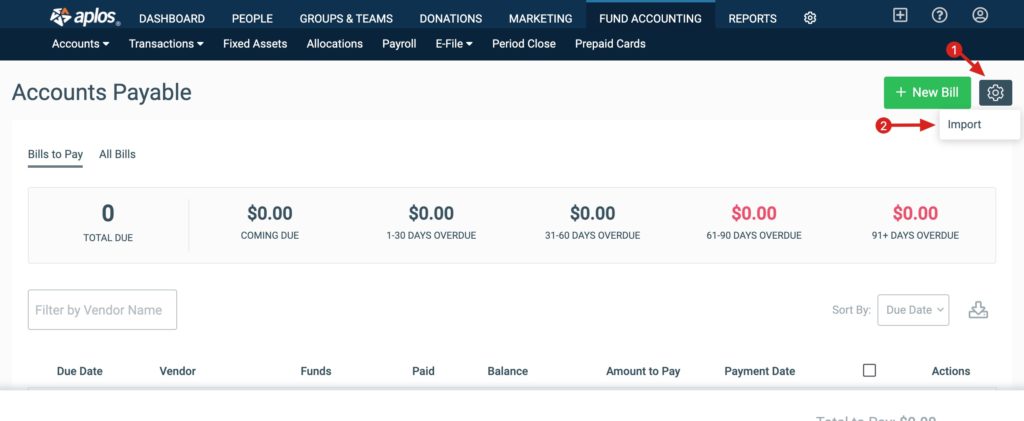
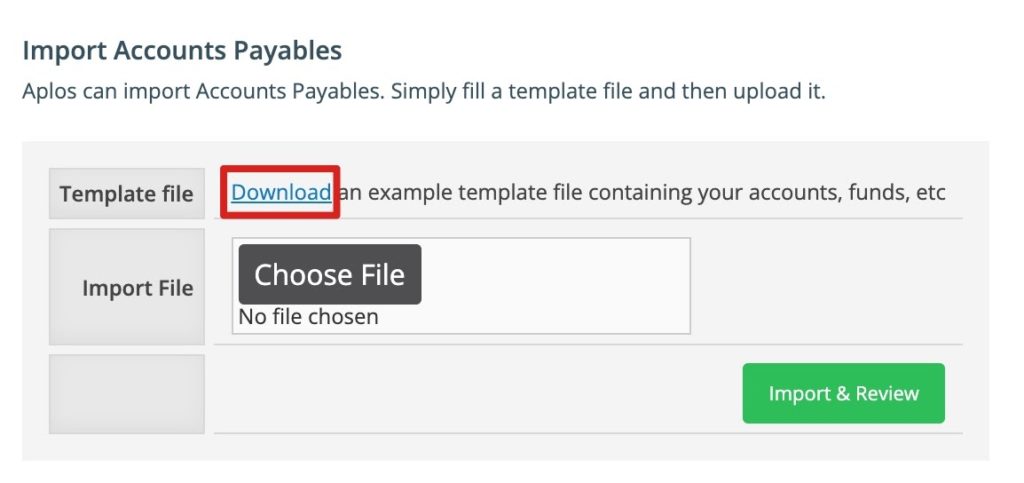
From the Import Accounts Payable screen, click “Download” to save the file for formatting. You will need Excel or another spreadsheet program that can save files in an .xls or .xlsx format.
Once downloaded, you can open the template. The first tab titled “Imports” is a templated format for your Accounts Payable. The following tabs include the list of your accounts, funds, and tags that are available in Aplos. When formatting your file, do not add any columns or rename any of the columns in the template.
Formatting Payable Details For Import
For each Accounts Payable entry, a Bill Date, Terms, and Due Date are required.
- Bill Date: The bill date is a unique identifier to distinguish when a new account payable entry starts. You will need to note one date on the first row of your account payable entry. The bill date is the date of the payable, and it will be used as its accrual date. This is a required field.
- Terms: The “Terms” field refers to the due-date range in which you expect this payable to be paid. You can use one of the following: no terms, due on receipt, net 15, net 30, or net 60. This is a required field for upload.
- Due Date: The due date is the date the bill is expected to be paid. This should be a valid Excel date (format: mm/dd/yyyy), and it is required if “Terms” is set to “no terms.” Leave the due date blank if “Terms” is not equal to “no terms.”

- Vendor: Vendor refers to the contact name that will be used for the payable. If the contact name does not exist in your Aplos database, it will be created upon import. This is a required field for upload. To avoid creating a duplicate contact, ensure that the spelling of the payee matches the entry in the contact database exactly. When uploading and reviewing your file, you can view any new contacts that will be created when the import is completed.
- Memo: You can use the memo field to add a note for the payable. This note will display on the bill if you print a check. This is a required field for upload.
- Reference #: The reference number is usually a bill number or unique identifier that will help you organize your payables. This is usually represented from the vendor on the bill itself. This will display on the bill if you print a check. This is a required field for upload.

Assigning Accounts, Funds, Comments, And Amounts
Next, you will need to enter the account and fund for your Accounts Payable import. If your bill needs to be split across multiple accounts or funds, you can create a second line item for the payable and provide the additional account or fund with the associated amount. To improve efficiency, utilize the tabs in the worksheet to copy and paste the accounts, funds, or tags into the corresponding cells. This will provide you with the correct formatting for your accounts and improve the success of your import.
- Account: This is commonly an expense account. The account will need to follow the format shown in the image above of (NUMBER – NAME). This is a required field for upload.
- Fund: The fund can be the number and name, the fund name, or just the fund number. This is a required field for upload.
- Comment: The comment is an internal note that will show on transactional reports for the account, fund, or tag you are reviewing.
- Amount: This refers to the dollar amount of the bill provided. If the bill is split, insert the amount of each split in their corresponding line item because the import will calculate the total amount.

Assigning A Tag To Payable Imports
If you have tags enabled, you’ll also have the option to include a tag. The Import Template will have columns added to the right of the Amount column for your tag layers. To check if you have tags enabled, you can view the Tag Management screen.
You can enter your tag name for any row on your Import Template. For example, if you have a tag layer called “Campuses,” you will see “Tags: Campuses” as one of your columns. If you have a tag for “North Campus,” you will enter that in the appropriate field.

The tag formatting can be the number and name (100 – North Campus), the tag name (North Campus), or just the tag number (100). You can also utilize the tabs on the worksheet to copy and paste the enabled tags into the corresponding cells.
Required Tags For Payable Imports
If your organization requires tags per transaction, it is recommended to include tags in the import. However, it is not required, and you can edit the entry after you import your file and post the entries to add any required tags.
Importing 990 Tags
If your organization has 990 tags enabled, a 990 tag is recommended when importing. However, you can complete the import without having 990 tags. You can also edit the account payable after you import your file and post the entries to add 990 tags.
Saving The Import Template
Once you review the data and ensure the accuracy of each entry, you will want to save the file under one of the following format types: .xlsx or .xls. To do so, click “File” and then “Save As” at the top of your screen. Choose where to save your worksheet, select the correct file format, and click “Save.”
Importing And Posting AP Entries
Once your file is formatted and you have saved it, you’re ready to import. From the Import Accounts Payable screen, click the Choose File button and select your file. Then click “Import & Review.”
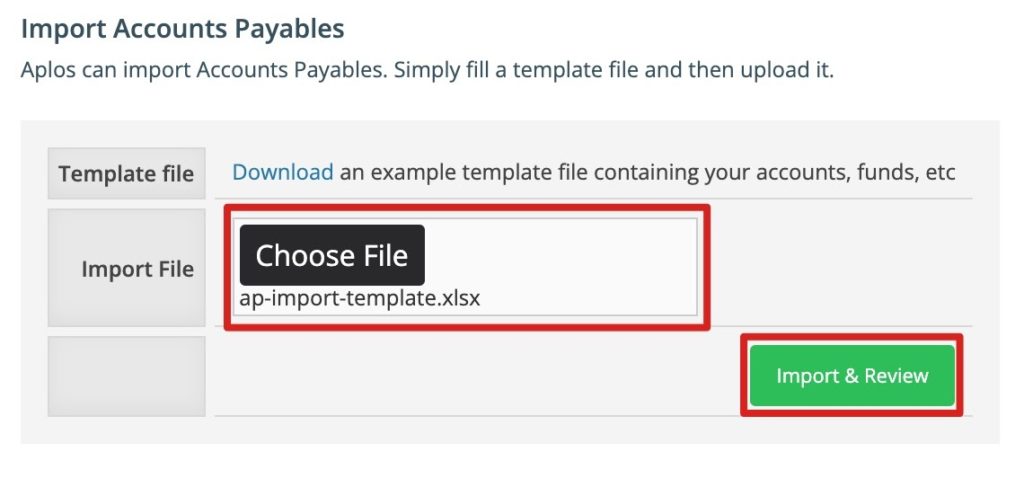
Once uploaded, you will review your imported file before completing the import and posting the payables in the system. From this screen, you can review errors in your file and view new contacts that will be created by this import.
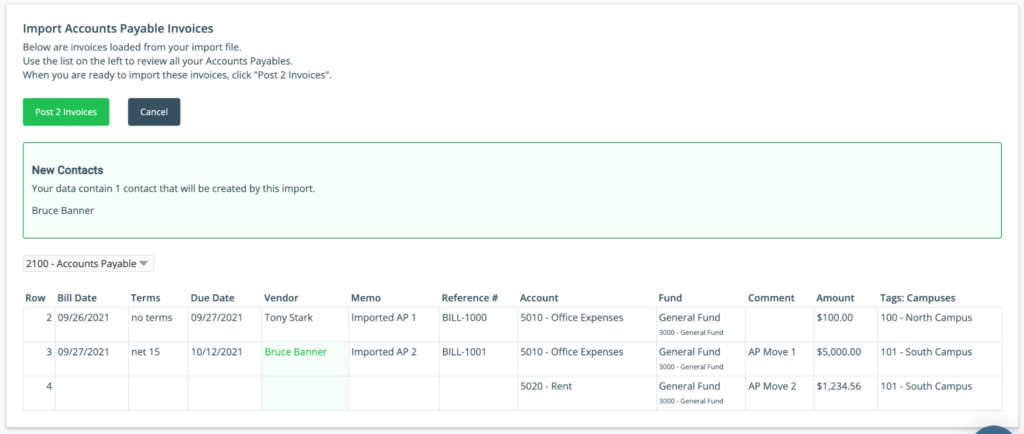
Post Invoice: You can post the transaction if there were no errors and you are ready to finish the import.
Once imported, the transactions will be reflected in your accounting and become an open bill in the Accounts Payable module. The bills can be further reviewed and edited in Accounts Payable. Until you post the entry, it is only pending and not yet applied to your accounting.
Cancel: You can click “Cancel” to go back to the Accounts Payable screen and not import the file.
Cancel and Restart: If you have an error in your file, you will need to update the file in Excel to correct the error and re-import your file. From the Review screen, click “Cancel and Restart.” This will take you back to the Accounts Payable screen where you can follow the steps for Importing Your File to continue. Once errors are cleaned up in the Excel file, you will be able to re-import the file and post any pending entries.
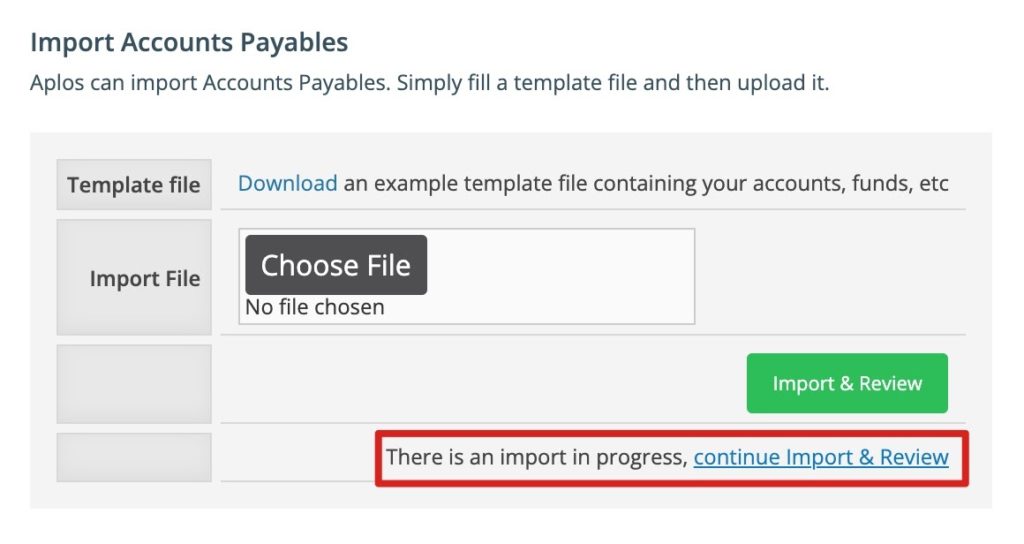
If you leave the Import Accounts Payable page at any point, you can return to it and select “continue Import & Review” to complete your pending import.
If you need assistance with this process, feel free to reach out to our support team at support@aplos.com.
AP Import Error Handling
When there is an error in your file, you will see a message, and entries will show an alert symbol and red text. To successfully import your entries, you will need to update the file in Excel and re-import it. From the Review screen, click “Cancel and Restart.” This will take you back to the Accounts Payable screen where you can follow the Importing Your File steps to continue.
Unrecognized Category (Account, Fund, Tag)
If you have included an unrecognized account or fund on your Import Template, you will see a red error message. You will need to enter the correct account or fund to proceed. Utilize the provided account or fund names on the Import Template tabs to resolve this error.
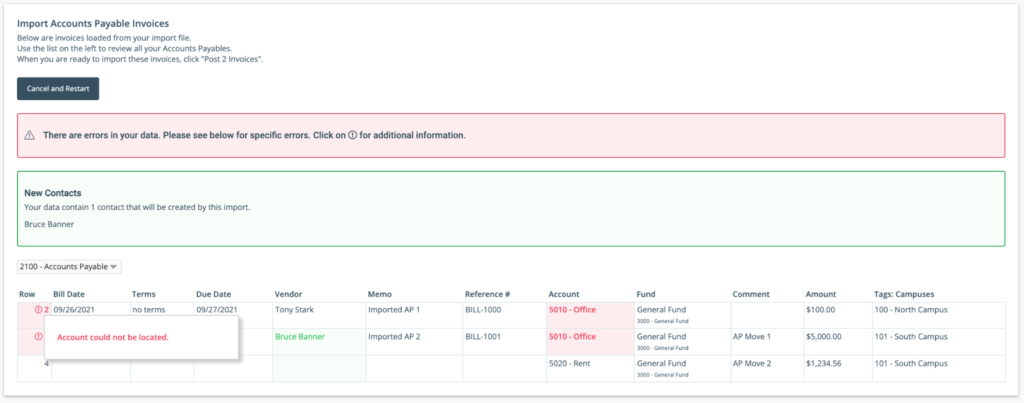
Importing Without Required Information
If you import your template and forget to include a required field, you will receive the following error. For information on which fields are required, see above or refer to the legend in the template file.
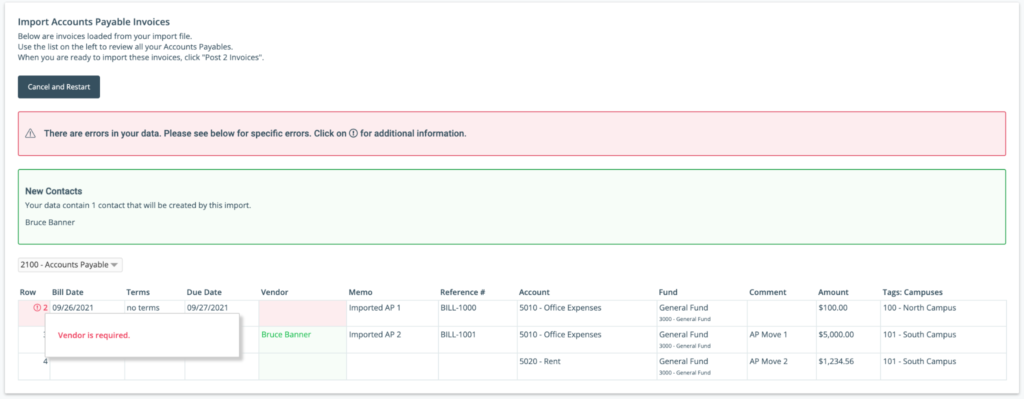
Importing Without A Bill Date Combines Bills
If you import your template and a bill date is missing for any of the entries, the import will not recognize the individual entry, and it will skip to the next one with a valid date. The entry with the missing date will become a part of the entry above it. You’ll need to go back to your template, add a date on the missing row, and re-import it.


